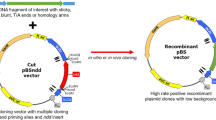Abstract
Objectives
To establish a positive cloning system with a zero background for high-throughput DNA cloning purpose.
Results
The cloning vector, pRI857, and the genomic-library construction vector, pRI857-BAC, were constructed based on the mechanism of expression of the thermo-sensitive cI857 repressor gene that can stringently repress the PR promoter and kanamycin resistance gene (PR-kan R) at 30 °C, but have no effect on PR-kan R gene at 37 °C or at higher temperatures. When the pRI857 vectors were transformed into E. coli with or without a target foreign DNA fragment inserted at the BfrBI site of the cI857 gene, only colonies with the foreign DNA fragment survive. We extended this method to construct a pRI857-BAC vector for genomic library cloning which displays an efficiency of ~107 cfu per µg of genomic DNA, with no empty vectors detected.
Conclusions
Cloning by indirect activation of resistance marker gene represents a novel DNA-capturing system, which can be widely applied for high-throughput DNA cloning.



Similar content being viewed by others
References
Bi CH, Su P, Müller J, Yeh YC, Chhabra SR, Beller HR, Singer SW, Hillson NJ (2013) Development of a broad-host synthetic biology toolbox for Ralstonia eutropha and its application to engineering hydrocarbon biofuel production. Microb Cell Factories 12:1–10
Breitling R, Sorokin AV, Behnke D (1990) Temperature-inducible gene expression in Bacillus subtilis mediated by the cI857-encoded repressor of bacteriophage lambda. Gene 93:35–40
Cherepanov PP, Wackernagel W (1995) Gene disruption in Escherichia coli: Tc R and Km R cassettes with the option of Flp-catalyzed excision of the antibiotic-resistance determinant. Gene 158:9–14
Datsenko KA, Wanner BL (2000) One-step inactivation of chromosomal genes in Escherichia coli K-12 using PCR products. Proc Natl Acad Sci USA 97:6640–6645
Gay P, Le Coq D, Steinmetz M, Ferrari E, Hoch JA (1983) Cloning structural gene sacB, which codes for exoenzyme levansucrase of Bacillus subtilis: expression of the gene in Escherichia coli. J Bacteriol 153:1424–1431
Guo B, Bi Y (2002) Cloning PCR products. An overview. Methods Mol Biol 192:111–119
Holton TA, Graham MW (1991) A simple and efficient method for direct cloning of PCR products using ddT-tailed vectors. Nucleic Acid Res 19:1156
Hurlbert RE, Gross DC (1983) Isolation and partial characterization of the cell wall of Pseudomonas syringae pv. syringae HS191: comparison of outer membrane proteins of HS191 with those of two plasmidless derivatives. Microbiology 129:2241–2250
Kovach ME, Elzer PH, Hill DS, Robertson GT, Farris MA, Roop RM, Peterson KM (1995) Four new derivatives of the broad-host-range cloning vector pBBR1MCS, carrying different antibiotic-resistance cassettes. Gene 166:175–176
Lepesant JA, Lepesant-Kejzlarova J, Pascal M, Kunst F, Billault A, Dedonder R (1974) Identification of the structural gene of levansucrase in Bacillus subtilis Marburg. Mol Gen Genet 128:213–221
Mitchell KM, Michaelis EK (1998) Multimembrane carbon fiber electrodes for physiological measurements of nitric oxide. Electroanalysis 10:81–88
Petersen KV, Martinussen J, Jensen PR, Solem C (2013) Repetitive, marker-free, site-specific integration as a novel tool for multiple chromosomal integration of DNA. Appl Environ Microbiol 79:3563–3569
Villaverde A, Benito A, Viaplana E, Cubarsi R (1993) Fine regulation of cI857-controlled gene expression in continuous culture of recombinant Escherichia coli by temperature. Appl Environ Microbiol 59:3485–3487
Acknowledgements
This work was supported by National Natural Science Foundation of China (Grant No. 21271104 and 21671103 for Yi J, and 31300111 for Wang Y). The strain Pseudomonas syrigae HS191 was a gift from Dr. Dennis C Gross (Texas A&M University).
Supporting information
Supplementary Table 1—The bacterial strains and plasmids used.
Supplementary Table 2—Sequence of primers used.
Supplementary Fig. 1—Plasmid map of the pRI857-BAC vector.
Supplementary Fig. 2—Cloning test of the ble R gene using pRI857 vector.
Supplementary Fig. 3—Cloning test of the PluxI-sfGFP gene using pRI857 vector.
Supplementary Fig. 4—Cloning test of the 16S rRNA gene from strain P. syringae HS191 using pRI857 vector.
Author information
Authors and Affiliations
Corresponding author
Ethics declarations
Conflict of interest
The authors declare no conflict of interest.
Research involving human and animal rights
This article does not contain any studies with human participants or animals performed by any of the authors.
Additional information
Accession Numbers
The sequences reported in this article were deposited in the GenBank database [accession numbers: KX774470 (pRI857), KX774471 (pRI857-BAC)].
An erratum to this article is available at http://dx.doi.org/10.1007/s10529-017-2316-3.
Electronic supplementary material
Below is the link to the electronic supplementary material.
Rights and permissions
About this article
Cite this article
Zhang, K., Su, H., Yang, M. et al. Construction of a thermo-sensitive pRI857 vector for efficient DNA capturing in Escherichia coli . Biotechnol Lett 39, 905–909 (2017). https://doi.org/10.1007/s10529-017-2313-6
Received:
Accepted:
Published:
Issue Date:
DOI: https://doi.org/10.1007/s10529-017-2313-6




